Stage 2: Semifinalists
We are happy to announce that, because of the large number of submittals and their high quality, we have expanded this years' number of Semifinalists. One hundred fifty two students from 26 countries entered this year's competition.
From these submittals, thirty-five authors from 17 countries have been advanced to the Semifinalist round (Stage Two) of the BERKELEY PRIZE 2013 competition. Semifinalists are now invited to submit a 2500-word Essay based on their 500-word Proposal. At least five, but up to seven, top Essays will be selected for final judging by this year’s BERKELEY PRIZE Jury.
All authors, whether promoted to Semifinalist status or not, can login to view the Readers’ comments regarding your Proposals.
New instructions for this year’s Semifinalists are included below.
Semifinalist Winners
|
Sophia Bannert
|
University of Lincoln
|
United Kindgom |
|
Aditi Bhagat and Shantanu Vishnoi
|
Indian Institute of Technology, Roorkee |
India |
|
Raveena Chauhan and Arnav Moulik
|
School of Planning and Architecture, Delhi |
India |
|
Bryan Chung
|
University of Melbourne
|
Australia |
|
Caitlin Copeland |
University of Edinburgh
|
United Kingdom |
|
Isabel Deakin
|
University of Melbourne |
Australia |
|
Slavka Gancheva
|
University of Edinburgh
|
Bulgaria
|
|
Ingrid Hansen
|
Dalhousie
|
Canada |
|
Racman Karin and Giada Attruia
|
University of Triest
|
Italy |
|
Mathias Kato
|
Uganda Martyrs University, Nkozi
|
Uganda |
|
Priyanshu Mani and Abhishek Mandal
|
Indian Institute of Technology, Roorkee |
India |
|
Faiq Mari
|
Birzeit University
|
Palestinian Territory
|
|
Malvika Mehta and Joyjeet Kanungo
|
School of Planning and Architecture, Delhi |
India |
|
Alexander Mohr
|
Münster School of Architecture, FH Münster
|
Germany |
|
Risley Mwatsama
|
Uganda Martyrs University, Nkozi
|
Kenya
|
|
Samuel Nakumanyanga
|
Uganda Martyrs University, Nkozi |
Uganda |
|
Shefali Nayak
|
Piloo Mody College Of Architecture
|
India |
|
Forhat Nazib
|
American International University, Bangladesh |
Bangladesh
|
|
Mandy Oeni and Lim Zhi Rui
|
National University of Singapore
|
Singapore
|
|
Daniel Olafsson
|
London Metropolitan University
|
United Kingdom |
|
George Podikas
|
Oxford Brookes University
|
Greece
|
|
Rushil Palavajjhala and Priyanka Sheth
|
Center for Environmental Planning and Technology |
India |
|
Rashmi Priya and Rushwanth Raghuram
|
Birla Institute of Technology, Mesra |
India |
|
Hanan Qureshi
|
Indian Institute of Technology, Roorkee |
India |
|
Aparna Ramesh
|
Visvesvaraya National Institute of Technology
|
India |
|
Szymon Ruszczewski
|
Universita' degli Studi di Firenze
|
Italy |
|
Disha Sahu
|
Sushant School Of Art And Architecture
|
India |
|
Monica Landgrave Serrano
|
Universidad de Sonora
|
Mexico |
|
Insha Sharma and Kaustav K. Bose
|
Birla Institute of Technology, Mesra
|
India |
|
Uzair Siddiqui and Aditi Veena Gupta
|
School of Planning and Architecture, Delhi |
India |
|
Johannes Lionel van Suntum
|
Berlin University of the Arts
|
Germany |
|
Piyush Verma and Parikshit Nema
|
School of Planning and Architecture, Bhopal
|
India |
|
Anna Vo
|
University of Technology, Sydney
|
Australia
|
|
Ben Wokorach
|
School of the Built Environment
|
Uganda
|
|
Noel Woodward and Rahul Kapil
|
School of Planning and Architecture, Bhopal
|
India |
General Information
We compliment all of the Semifinalists on the extraordinary diversity of ideas and approaches in response to this year’s Question. Such responses indicate the depth of interest in and concern for the social art of architecture.
In Stage Two, you are to expand upon your chosen topic in 2,500 words. The BERKELEY PRIZE Committee encourages Semifinalists to improve the crafting of their ideas. A few suggestions as to how you can make your Essay more effective for both professional and non-professional readers:
-
Before you begin to write the 2,500 word essay, it is essential that you carefully consider the Readers' comments about your Proposal. These comments are meant to help you write a winning essay. Please read your reviewer comments in your Author Portfolio.
-
An essay is different from a Proposal. Your Proposal was selected because the Committee believed that it was a good outline that had the potential to be developed into an even better essay on the social art of architecture. You want to do more – much more - than simply re-state your argument. Explore and expand your ideas, the reasons for them, and the conclusions you have reached because of them. Substantiate these thoughts with specific examples.
-
Remember: the Question asks not only what is being done in your city to make it accessible, but what MORE can be done. Talk with disabled persons who use these improvements. Talk with those responsible for instituting the improvements. Talk with the architect(s) and/or designer(s) who have developed the actual design solutions. What more do they think should be done? What more do you think should be done? Be specific – and creative. The best Essay is focused: address the larger issues, but concentrate on discussing specific concerns that you have identified and for which you think you have some good solutions.
-
In answering the Question, the BERKELEY PRIZE Committee is particularly interested in responses that speak to the general public. If social architecture is to become the norm, rather then the exception, the public must be persuaded of the value of design that reflects human worth. If social ideas are to be realized, rather then simply discussed, the public must be persuaded that there is added value to initiating your idea as opposed to doing nothing. This means selecting a voice that is both your own, and one that is accessible to both serious readers and those who read only the "lead" points.
-
Ask a friend to read your essay before submitting it. Better yet, show it to two friends: one, a fellow architecture student; the second, a person not familiar with the discipline or profession. Use their input to revise your draft. If you can prevail on them, ask them to read your revised draft. Ask them how your argument can be made clearer – it always can be.
Illustrations
We ask that you include four (4) digital photographs of images that help describe the content of your essay. One of these photos can be the image you already posted with your Proposal, but it needs to be re-posted. The photograph should be no larger then 1 MB, and be in .jpeg format. No more then four photographs will be accepted. You can use a digital camera, a film camera (and scan the printed image), or even capture the image on a cell phone and transfer it to your document. There is space provided at the end of the submittal form to upload the images. Space is also provided to number and caption each image.
In selecting these four images, imagine that a publisher or editor of an online blog, or a newspaper, or a magazine have accepted your essay for publication. One of their requirements is that you supply four illustrations that help describe and explain the points made in your essay. What illustrations would you submit that not only provided the basic information about your topic, but also help further your written arguments? As part of this process, refer to these illustrations at the appropriate spots within your essay.
Remember, however, one of the primary purposes of the essay format is to test your skill in describing a situation in words, rather then pictures or drawings. Do not assume that just because you have posted the photographs that your responsibility to carefully describe in words your selected topic is reduced. To the contrary: use the illustrations to support and strengthen your writing.
Improving Your Writing
You have almost six weeks to produce your essay in final form. Use as much of this time as possible to attempt to actively improve your writing abilities, particularly if English is not your first language. Read some good prose written in English, especially essays, whether from the field of architecture or from other disciplines. In architecture, search for articles written by architectural journalists and popular architectural historians who write for a general audience online, in newspapers, and in widely circulated magazines. Think about how they present arguments and describe buildings and places. Use websites, such as reference.com to improve your English vocabulary, syntax, and spelling.
Avoid the use of professional language unfamiliar to many of your intended readers, except where absolutely necessary. Above all, avoid jargon. In describing your subject matter you might want to use this assist: Imagine that you are describing the situation and setting to a person who is blind. How would you describe the details of what is and what you think there should be to them? (Given this year’s Question, this approach is doubly relevant!
Whether or not English is your first, second, or fifth language, again, do not hesitate to review your essay with an experienced English language-speaker and writer. Use their suggestions as how to make your argument as clear, precise, and interesting as possible.
MOST IMPORTANTLY, HAVE FUN AND GOOD LUCK!
Proposals due anytime before midnight, GMT, February 1, 2013
|
|
|
 Like everyone else, this worker in Mexico needs transportation to his job. Public transport needs to be accessible for persons with mobility, sensory, and cognitive disabilities.  Persons with disabilities around the world are promoting transport systems that provide mobility for everyone. Mexican disability advocates are shown meeting with local transit officials to promote accessible transport. AEI has published guides to assist planners and advocates of inclusive transportation.  An accessible travel chain begins with safe streets and sidewalks. This street in Foshan, China, has separate rights-of-way for pedestrians, human-powered vehicles, and motor-powered vehicles.  Disability advisors at Rio de Janeiro’s Independent Living Center monitored access features for this street crossing, part of the Rio City Project.  Tactile guideways and tactile warning strips assist blind and sight-impaired pedestrians as well as others in Foshan, China.  Tactile warnings alert this blind person crossing a mid-street island in San Francisco, USA. 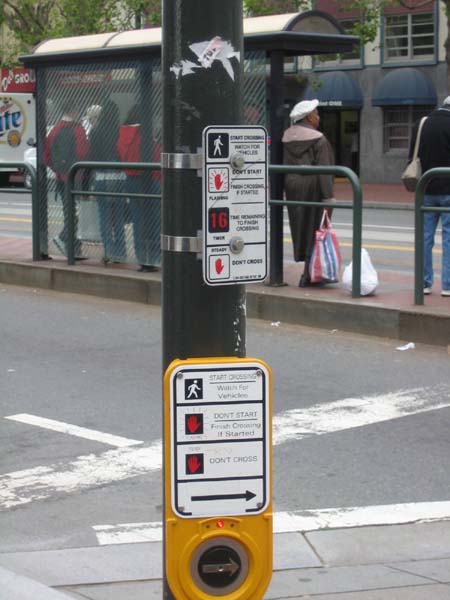 Busy intersections benefit from pedestrian controlled buttons and assist blind persons to cross through sound and vibration signals 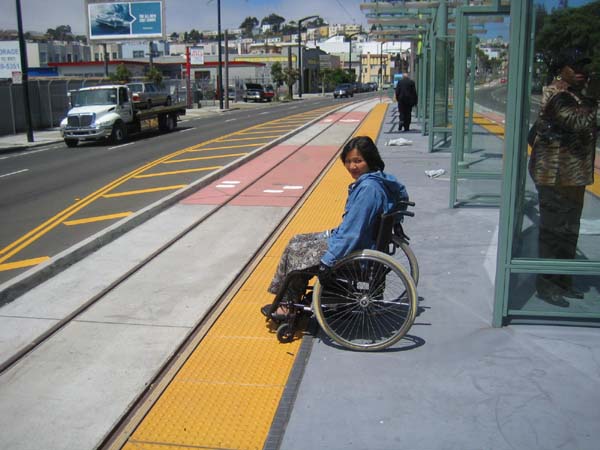 Tactile warnings protect blind persons – and all other passengers – from getting too close to the platform edge in transit stations. 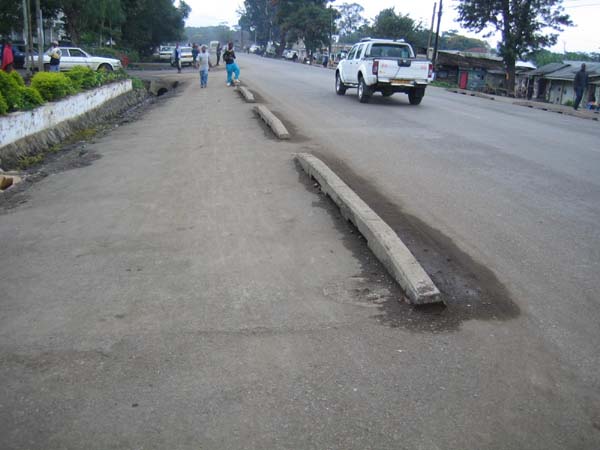 This footway adjacent to a road in Tanzania is protected by curb pieces which separate motor traffic from pedestrians and bicycles. Such basic safety measures are needed to prevent pedestrian injuries along roadways in many countries. 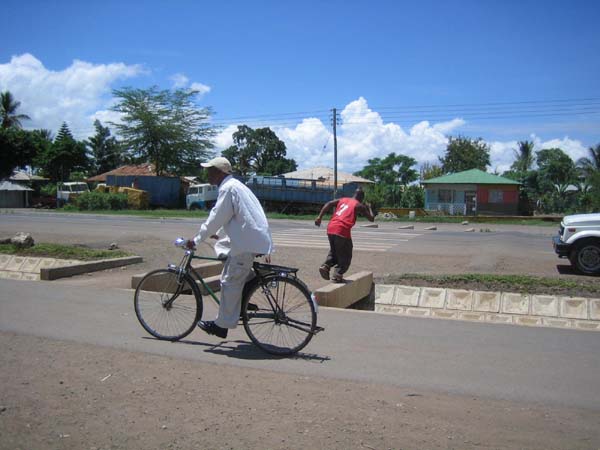 Even better, pedestrian and non-motorized traffic can be kept safely removed from motorized traffic by accessible sidewalks separated from the roadway, in this case by a well-designed drainage system along a main road in Tanzania. Speed bumps are used to slow traffic at crosswalks.  This pedestrian crosswalk provides level access to a bus island at an inter-modal transfer center in Mexico City.
Photo by T. Rickert, courtesy of DFID (UK) and TRL (UK).  Ticket vending machines should be low enough for use by wheelchair users and all short persons, as illustrated by the good design of this machine at a BART station in the San Francisco Bay area, USA.  Stairs are often retrofitted with stair lifts in transit terminals, as here in a Tokyo subway station. However, in new construction, elevators should be considered where possible.  A wheelchair user takes the elevator from the platform level of the Shenzhen, China, railroad station.  Wide doors are needed to accommodate wheelchair riders entering fare-paid areas of transit terminals, as in this subway station in Rio de Janeiro. 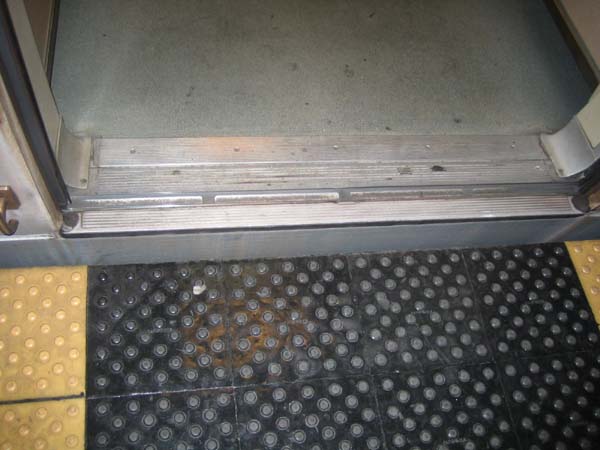 Everyone can safely board this BART train, due to a minimal horizontal and vertical gap. 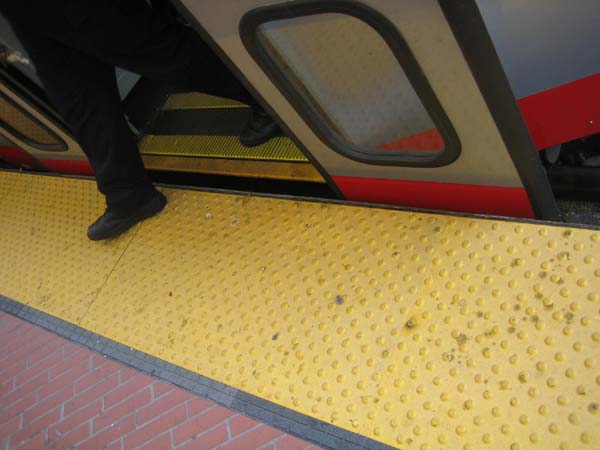 However, care must be taken that horizontal gaps are not too wide. The orange “gap filler” pops up when the doors open in San Francisco’s Muni Metro, assuring a safe gap.  Small portable ramps can provide inexpensive access in many rail stations, as shown here in Tokyo.  All passengers, and especially deaf and hard-of-hearing passengers, benefit from well-located visual information, as with this route display on board a train to the Hong Kong airport. 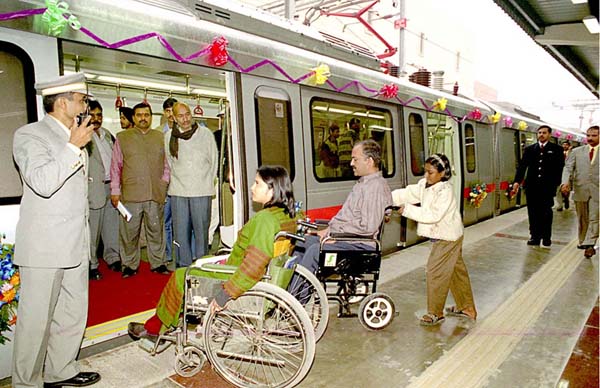 Advocates Anjlee Agarwal (left) and Sanjeev Sachdeva board the accessible Delhi Metro on its inaugural run.
Photo courtesy of Sanjay Sakaria and Samarthya, from Amar Ujjala Indian Daily  Express buses in Curitiba, Brazil, exemplify universal design. All passengers, including those with disabilities, quickly board with level entry. Similar Bus Rapid Transit (BRT) systems operate in Quito, Ecuador; Bogota, Colombia, and a growing number of cities around the world.
Photo by Charles Wright, Inter-American Development Bank.  Construction of this Bus Rapid Transit (BRT) trunk line corridor in Pereira, Colombia, symbolizes the rapid spread of BRT systems around the world. BRT systems lend themselves to universal design, but details must be monitored carefully to maximize accessibility. 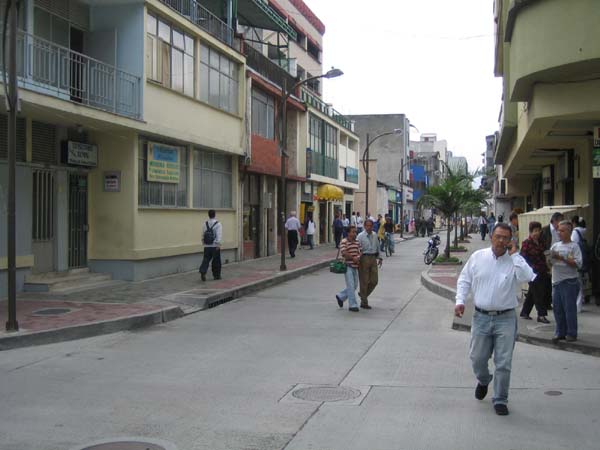 Although most BRT busways are on broad thoroughfares, this exclusive single-direction bus lane nearing completion in Pereira illustrates that BRT systems can sometimes be built on narrow streets.
This and above photo by T. Rickert courtesy of World Bank 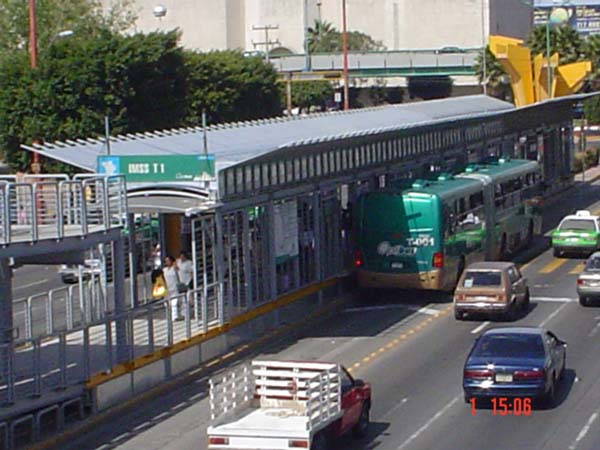 The photo shows an articulated bus docking at a Bus Rapid Transit station in León, Mexico. 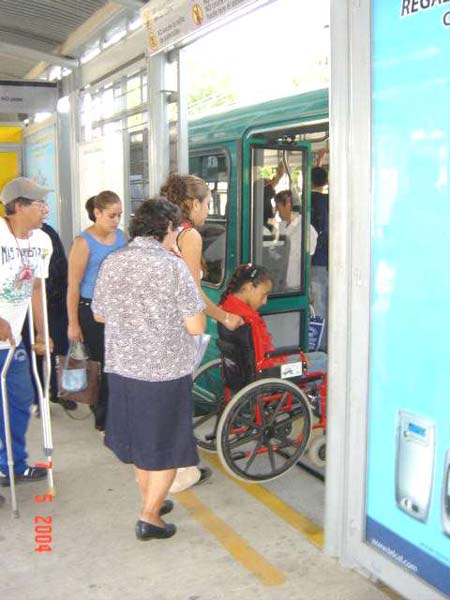 Pre-paid passengers inside a station board a high-capacity BRT bus in León.
This and above photo courtesy of Sistema Integrado de Transporte Masivo de León 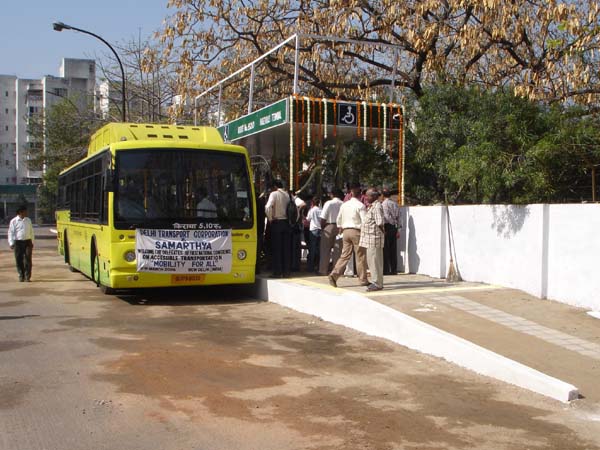 A prototype low-floor bus is tested in New Delhi adjacent to a platform the same height as the bus floor. 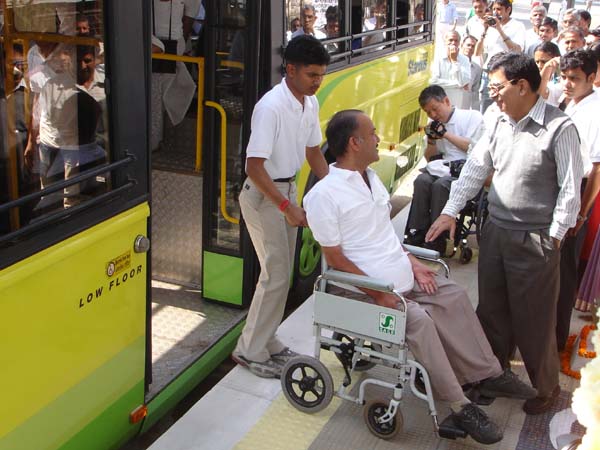 A closeup of the same bus stop illustrates the advantages of fast boarding for all passengers from platforms that eliminate the need for climbing steps to board.
This and above photo courtesy of Gerhard Menckhoff of the World Bank. 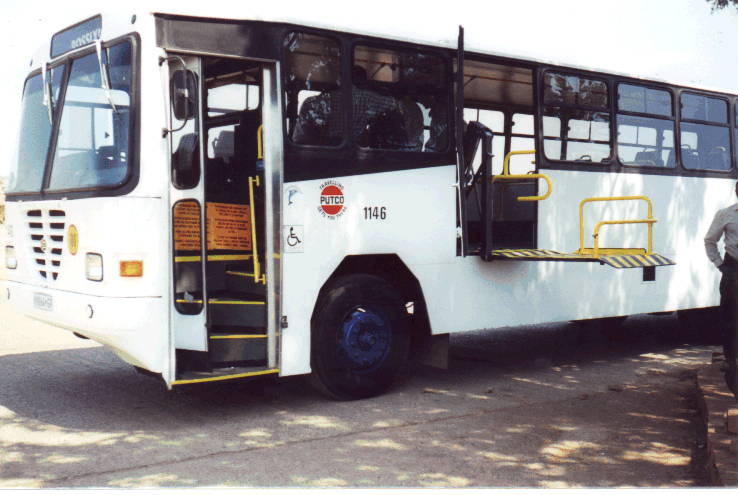 This prototype lift-equipped bus serves Mamelodi Township in South Africa. Note the excellent use of contrasting colors.
Photo by T. Rickert, courtesy of DFID (UK) and TRL (UK).  Mexico City officials inaugurated service in 2001 with 50 new buses equipped with lifts and other access features.
Photo courtesy of Marìa Eugenia Antunez.  In addition to a wheelchair lift, this bus in Mexico City has a retractable step beneath the front entrance.  This low-floor bus in Warsaw, Poland, uses an inexpensive hinged ramp which provides easy boarding for passengers with disabilities.  A low-floor bus in Hong Kong also exhibits excellent color contrast, using a bright yellow on key edges and surfaces. 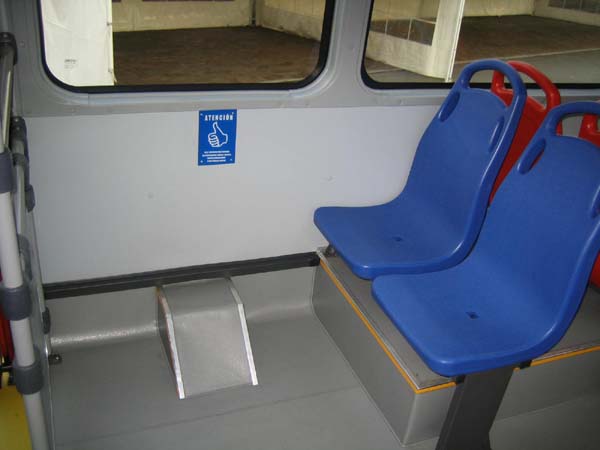 Transit systems around the world have reserved seating for seniors and passengers with disabilities, and often for pregnant women as well, as found on this TransMilenio bus in Bogotá, Colombia. 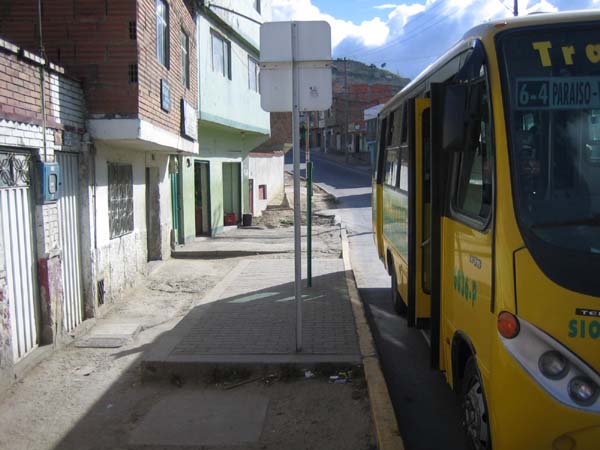 Even when bus stops are not accessible to wheelchair users, access for seniors and others with disabilities can be enhanced by a level all-weather pad even in the absence of paved sidewalks. The photo is from a TransMilenio feeder route in Bogotá.
This and above photo by T. Rickert courtesy of World Bank.  Thousands of Mexico City’s small inaccessible microbuses are being recycled and replaced with larger vehicles, often with better access features.  One such feature is this priority seating located behind the driver where there is extra leg room and it is easier for blind passengers to hear the driver call out key stops.
Photo by T. Rickert, courtesy of DFID (UK) and TRL (UK).  In other new buses in Mexico City, a wide rear door has low steps and is easily accessed by semi-ambulatory passengers from a raised sidewalk, but requires that drivers carefully pull in to the curb.
Photo by T. Rickert, courtesy of DFID (UK) and TRL (UK). 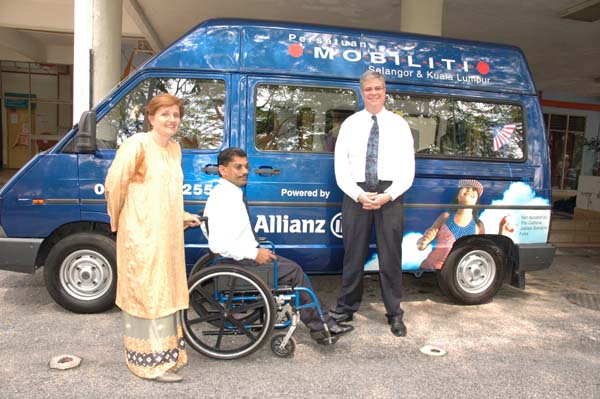 Community initiatives are playing a growing role in providing accessible door-to-door transport in many countries. This accessible van in Kuala Lumpur, Malaysia, belongs to the six-vehicle fleet of Persatuan Mobiliti.
Photo courtesy of Persatuan Mobiliti  Artist’s conception of a three-wheeled door-to-door vehicle connecting with an accessible ramped platform with bridge at a bus stop at a key site.  This prototype three-wheeled vehicle was built with AEI’s assistance by Kepha Motorbikes in Nairobi, Kenya.  Detail showing entry via a ramp at the rear of the test vehicle.
This and above photo courtesy of Wycliffe Kepha.  This accessible bicycle rickshaw in India has a rear door which serves as a ramp.
Photo courtesy of Bikash Bharati Welfare Society and Lalita Sen. 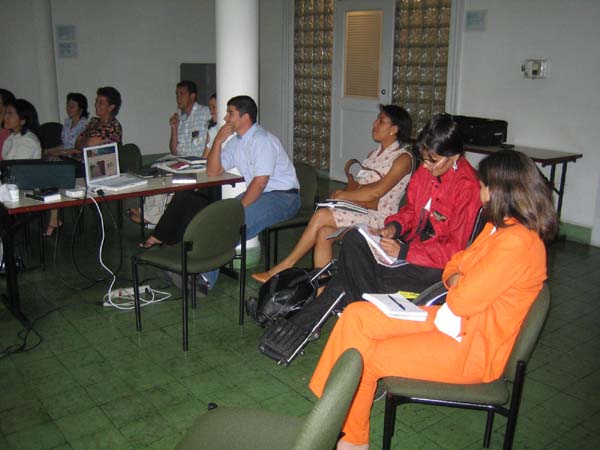 A public meeting in Cali, Colombia, discusses accessibility to Bus Rapid Transit systems. Readers can go to the Bus Rapid Transit Accessibility Guidelines in our Resources section, under the links to the World Bank.
Photo by T. Rickert, courtesy of the World Bank. 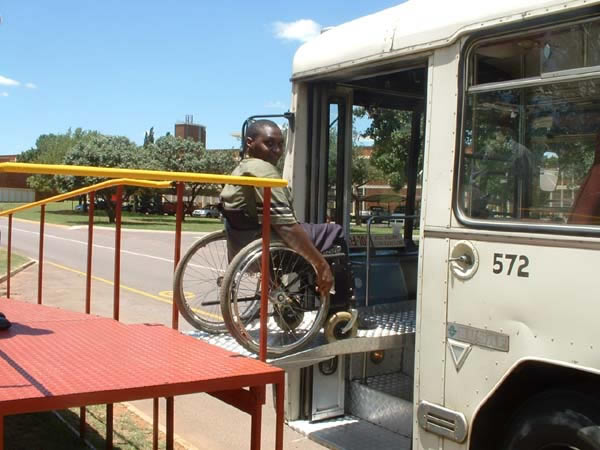 In this version, the bridge piece is mounted under the platform and put into place by the bus driver.
This and above photo courtesy of DFID (UK) and CSIR Transportek (South Africa). 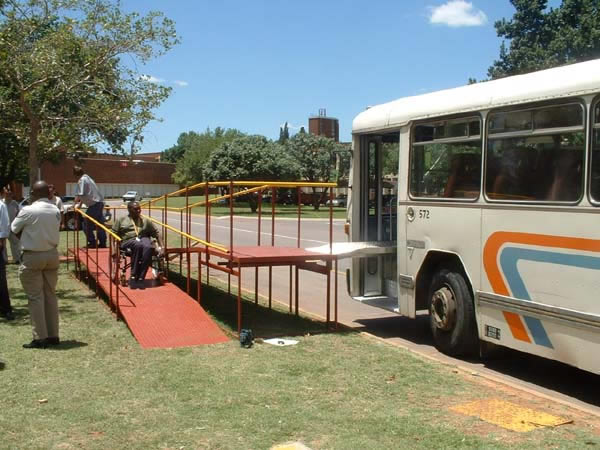 This test in South Africa of a prototype platform for use at key sites shows an alternative approach to access for wheelchair users.
|
|













































